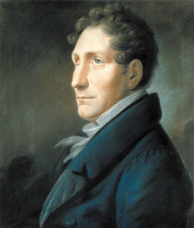Friedrich Kuhlau

Friedrich Daniel Rudolf Kuhlau(German;DanishsometimesFrederick Kulav) (11 September 1786 – 12 March 1832) was a Danish pianist and composer during the lateClassicaland earlyRomanticperiods. He was a central figure of theDanish Golden Ageand is immortalized in Danish cultural history through his music forElves' Hill,the first true work of DanishNational Romanticismand a concealed tribute to theabsolute monarchy.To this day it is his version of this melody which is the definitive arrangement.
During his lifetime, Kuhlau was known primarily as a concert pianist and composer of Danishopera,but was responsible for introducing many ofBeethoven's works, which he greatly admired, to Copenhagen audiences. Kuhlau was a prolific composer, as evidenced by the fact that although his house burned down, destroying all of his unpublished manuscripts, he still left a legacy of more than 200 published works in mostgenres.
Early life and education
[edit]Kuhlau was born on 11 September 1786 just south ofLüneburgin theUelzendistrict ofLower Saxony(Germany). At the age of seven, he lost his right eye when he slipped on ice and fell. His father, grandfather, and uncle were militaryoboists.Even though Kuhlau was born to a poor family, his parents managed to pay for piano lessons. In 1802 he moved toHamburgwhere he began learning thepianowith scholarC.F.G Schwencke.[1][2]
Career
[edit]In 1804, Kuhlau made his debut and began working as a concert pianist. It was around this time that he began composing songs andchamber musicto earn money. Many ofKuhlau's compositionsthroughout his life were for the flute, though he himself did not play the instrument. In 1810, he fled toCopenhagento avoid conscription in theNapoleonic Army,which overwhelmed the many small principalities andduchiesof northern Germany. In the same year, Kuhlau published his first piano and flute compositions. Kuhlau made a living inCopenhagenas a piano teacher and composer in 1811. He was later appointed as a non-salaried musician in the Danish Court in 1812. Kuhlau eventually became aDanishcitizen in 1813. Following the success of his singspiel,The Robber's Castle,Kuhlau achieved a high-paying position as a singing teacher at the Royal Theater in 1816. Kuhlau's works between 1817 and 1820 failed to gain much prominence. His opera,The Magic Harp,was said to have failed due to a controversiallibretto.In 1821 and 1825, Kuhlau travelled toViennawhere he befriendedLudwig van Beethoven.Beethoven's influence is evidential in Kuhlau's later works such as his singspiel,ElverhøjorElves' Hill,a work widely regarded as a tribute to theDanish Monarchyand an inspiring piece from theDanish Golden Age.In 1828, Kuhlau was awarded an honorary professorship.[3]
Music
[edit]Operatic works
[edit]Kuhlau had his breakthrough in 1814 at theRoyal Danish TheatrewithRøverborgen( "The Robbers' Castle" ), asingspielwith a libretto byAdam Oehlenschläger.[4]
His next dramatic works, includingTrylleharpen(1817),Elisa(1820) andHugo og Adelheid(1827), lacking drama, failed miserably. WithLulufrom 1824 he finally once again experienced success with one of his singspiels. He also wrote music for performances ofWilliam Shakespeare's plays.[5]
In 1828 he achieved his greatest success when he wrote the music forElverhøj.It won immediate popularity, especially for itsovertureand the final royal anthem, his setting ofKong Christian stod ved høien Mast(King Christian Stood by the Towering Mast). In the music, Kuhlau made very effective use of Danish and Swedish folk tunes. In 1976 the overture was rearranged by Danish composerBent Fabricius-Bjerreand used as the soundtrack in a scene in the filmThe Olsen Gang Sees Red.The scene depicts the Olsen Gang breaking into The Royal Theater of Copenhagen, making their way through bricked up walls using explosives and other means. The whole break-in is choreographed so it corresponds directly to the music. The scene is one of the most – if not the most – recognized in the history of Danish film.
Other works
[edit]Alongside his dramatic works, Kuhlau wrote several compositions for flute and a large number of works for piano. Particularly his short pieces,sonatinas,for piano, enjoyed great popularity both in Denmark and abroad.
Beethoven, whom Kuhlau knew personally, exerted the greatest influence upon his music. Kuhlau's C major Piano Concerto, Op. 7 from 1810 displays a strong influence from Beethoven'sPiano Concerto No. 1 in C major,written 14 years earlier. All three movements of the work are strongly reminiscent of the corresponding movements in Beethoven's work, making it a musicalpastiche.
In addition to the above-mentionedpiano concertowere astring quartetand several works for piano that included all the current genres of the day:sonatas,sonatinas,waltzes,rondosandvariations.He also created several works for strings with piano (threequartetsand twoquintets,and severalviolin sonatas), works ofincidental musicand severaloperas.However, his most-often recorded and played works are several piano sonatinas and numerous works forflute.It is because of these flute works that he was nicknamed "the Beethoven of the flute" during his lifetime.
See also
[edit]References
[edit]- ^"Friedrich Daniel Rudolf Kuhlau".The Kennedy Center.Retrieved2020-05-25.
- ^"Denmark - Culture - Music".Foreign Ministry of Denmark. Archived fromthe originalon January 8, 2007.Retrieved2010-08-23.
- ^"Friedrich Kuhlau, Biography by Robert Cummings".All Music.Retrieved2020-05-25.
- ^"Frederik Daniel Rudolph Kuhlau".Golden Days. Archived fromthe originalon 2011-07-19.Retrieved2010-08-23.
- ^"Frederik Kuhlau".Gyldendal.Retrieved2010-08-23.
- Some of the information on this page appears on the website of Edition Silvertrust but permission has been granted to copy, distribute and/or modify this document under the terms of theGNU Free Documentation License.
External links
[edit] Media related toFriedrich Kuhlauat Wikimedia Commons
Media related toFriedrich Kuhlauat Wikimedia Commons- List of worksat theWayback Machine(archived June 26, 2008) International Friedrich Kuhlau Society
- Friedrich Kuhlau Grand String Quartet Op.122Soundbites and short biography
- Free scores by Friedrich Kuhlauat theInternational Music Score Library Project(IMSLP)
- TheMutopia Projecthas compositions byFriedrich Kuhlau
- Friedrich KuhlauatAllMusic
- Friedrich KuhlauatIMDb
- Friedrich KuhlauatFind a Grave
- 1786 births
- 1832 deaths
- 19th-century classical composers
- 19th-century Danish composers
- 19th-century German composers
- 19th-century German male musicians
- Classical musicians with disabilities
- Composers for piano
- Danish Romantic composers
- Danish classical pianists
- Danish opera composers
- Danish people of German descent
- German emigrants to Denmark
- German classical pianists
- German male classical composers
- German opera composers
- German Romantic composers
- Danish male opera composers
- Naturalised citizens of Denmark
- People from Uelzen
